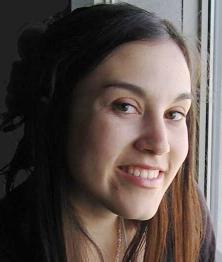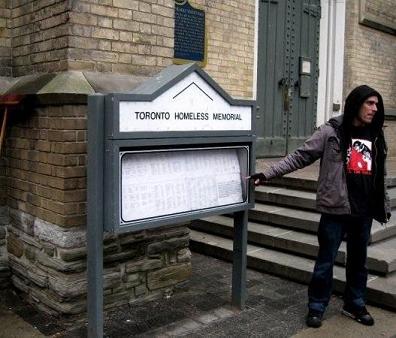| Civic Engagement and Civic Spaces |
![PDF-NOTE: Internet Explorer Users, right click the PDF Icon and choose [save target as] if you are experiencing problems with clicking.](http://rsnonline.org/templates/rsntemplate-smallmasthead/images/pdf_button.png) |
 |
|
Page 1 of 3 Rebekka King, University of Toronto
Religion in the CityOne of my aims of teaching religion is to make the familiar seem unfamiliar. It was with this in mind that I took my third-year undergraduate class, “Religion and the City,” to a Salvation Army shelter in downtown Toronto. For two hours, our guide and local expert, Anthony, a former crack-addict who had lived on the streets for eight years, gave my class a tour of the city, our city, from the perspective of a person experiencing homelessness. “It was a lot quieter before the revitalization,” Anthony remarked as we walked through Toronto’s Yonge and Dundas Square (which some call the Times Square of Canada). We had just walked through the massive Eaton’s Centre when I turned to make sure that I had not lost any would-be shoppers to the call of the mall and observed several students reaching for their cameras to snap pictures of Canada’s busiest intersection. I was somewhat surprised by their desire to capture this moment — the students’ interaction with this space stood in sharp contrast to Anthony’s intimate knowledge of the site. This interlude raises important questions about the necessity of offering opportunities for civic engagement both inside and outside our classrooms. This course offered students a chance to develop their own theory that could then be applied across historical and cultural realms. I specifically was interested in encouraging the students to look at the ways that religious and secular narratives described and constructed categories of the insider and outsider within civic spaces. I emphasized that we can understand meaning-making as deriving from both official and unofficial narratives. In doing so, I wanted them to understand that their lived experiences outside of the classroom could also serve as primary sources or “texts” available for scholarly examination (Morton, 2002: 41–42). The course texts — biblical passages, novels, poetry, essays, documentary films, and a field trip — provided case studies with which we, as a class, could develop a theoretical approach to non-conventional sacred spaces in both ancient and contemporary worlds. In the first half of the course we read, among other texts, the Epic of Gilgamesh, which we used as the model for exploring specific questions related to ontological constructions of the self and community. In the second half of the course we read Michael Ondaatje’s In the Skin of a Lion (Knopf Doubleday, 1997), which is a modern retelling of the Gilgamesh narrative set in early twentieth century Toronto. Ondaatje’s poetic novel combines fiction and reality to tell the unofficial history of the working-class immigrants responsible for the construction of Toronto. More than once we joked that we were starting our own religion, “Ondaatje-ism,” which would have certainly dismayed the well-known Canadian fiction icon. Although we did not start our own religion, we did develop our own theory. With a healthy dose of Foucault and Jonathan Z. Smith, we constructed a theory that we were confident applying to several case studies. I suggested to the students that in respect to the title of our course, “Religion and the City,” perhaps there is a religion of the city that could be identified in Ondaatje’s novel. The characters in the novel are forced to express their identity by investing in nonconventional spaces while opposing established authority structures. Our task then was to ask the same questions about, and to apply the same theory to, contemporary Toronto. More specifically, who is included and excluded in the physical construction and cognitive imaginings of Toronto in 2010? What sites become nonconventional sacred sites to those who define themselves as citizens non grata in opposition to the establishment?
So it was on a chilly March morning I took my class to the shelter where they spoke first with Dion Oxford, the manager, who addressed the challenges of urban homelessness. He then turned the class over to the aforementioned Anthony, who runs walking tours of the city to provide community groups with insights into the ways in which individuals experiencing homelessness navigate Toronto’s downtown core. |


 Rebekka King is a PhD candidate in the Centre for the Study of Religion at the University of Toronto. She is working on a dissertation titled “The New Heretics: Pop-theology and Progressive Christianity.” Her research involves an ethnographic and linguistic analysis of contemporary Christianity in North America.
Rebekka King is a PhD candidate in the Centre for the Study of Religion at the University of Toronto. She is working on a dissertation titled “The New Heretics: Pop-theology and Progressive Christianity.” Her research involves an ethnographic and linguistic analysis of contemporary Christianity in North America. These questions were addressed in a major assignment for the course. I instructed students to select their own spaces within the city of Toronto that they felt resembled spaces described above and to apply our theory to those sites. In order to help them, I offered my own example, the Salvation Army’s Gateway Shelter and Drop-in Centre, for people experiencing homelessness in downtown Toronto.
These questions were addressed in a major assignment for the course. I instructed students to select their own spaces within the city of Toronto that they felt resembled spaces described above and to apply our theory to those sites. In order to help them, I offered my own example, the Salvation Army’s Gateway Shelter and Drop-in Centre, for people experiencing homelessness in downtown Toronto.